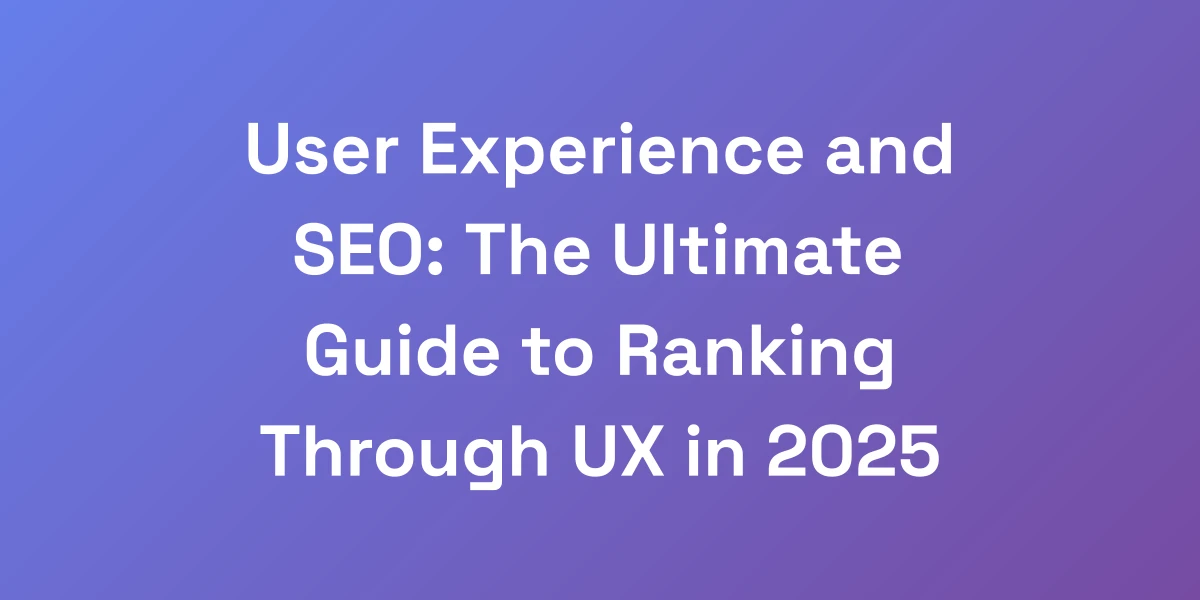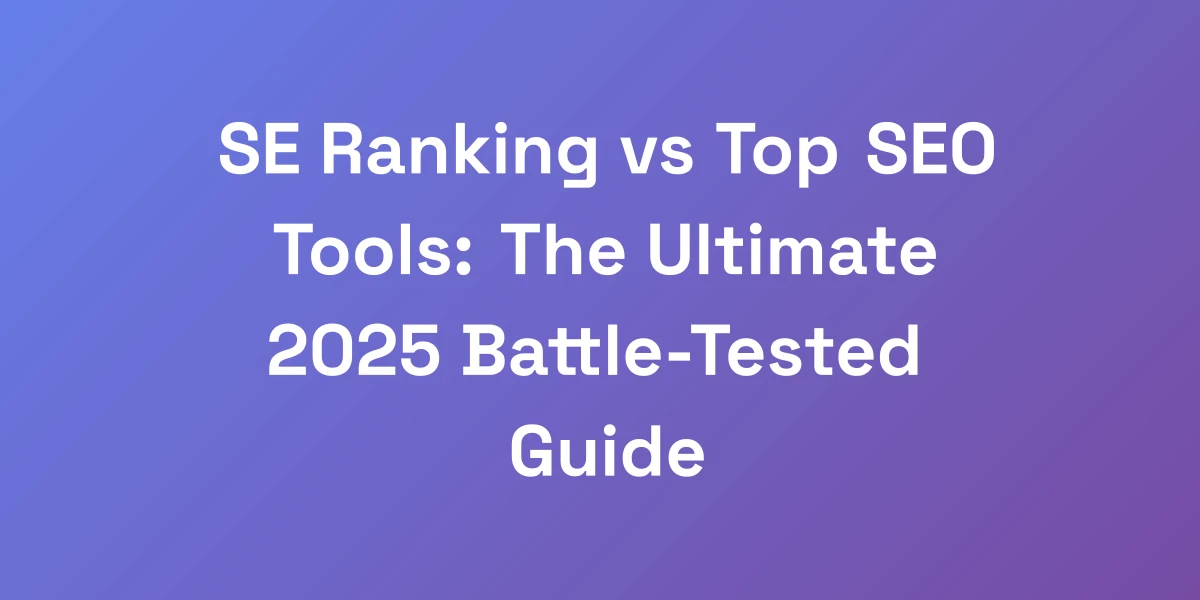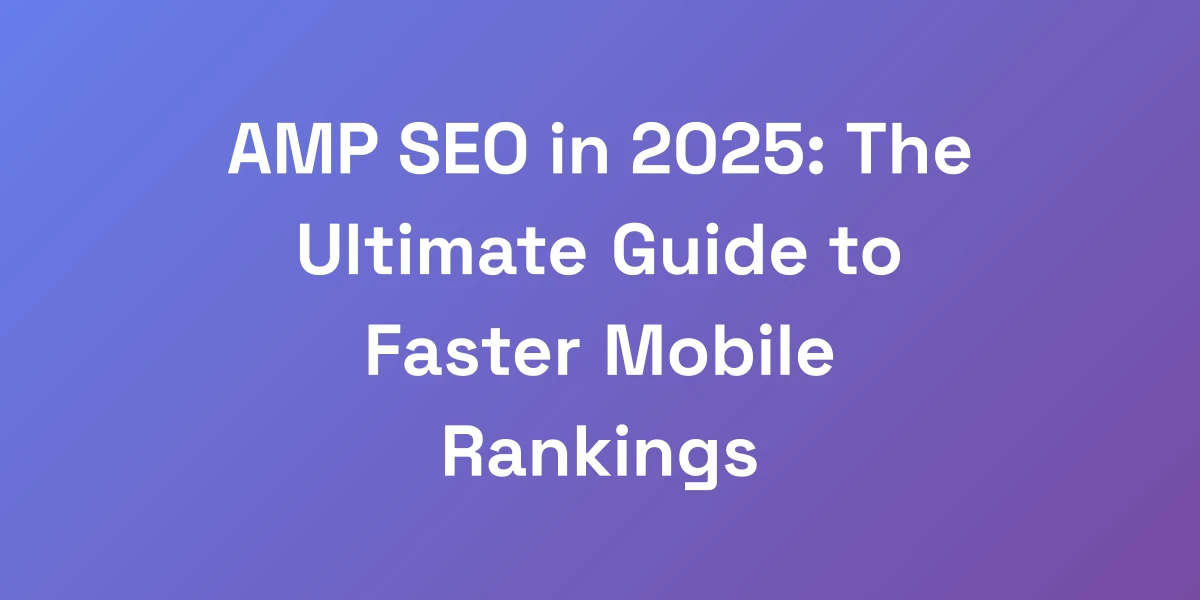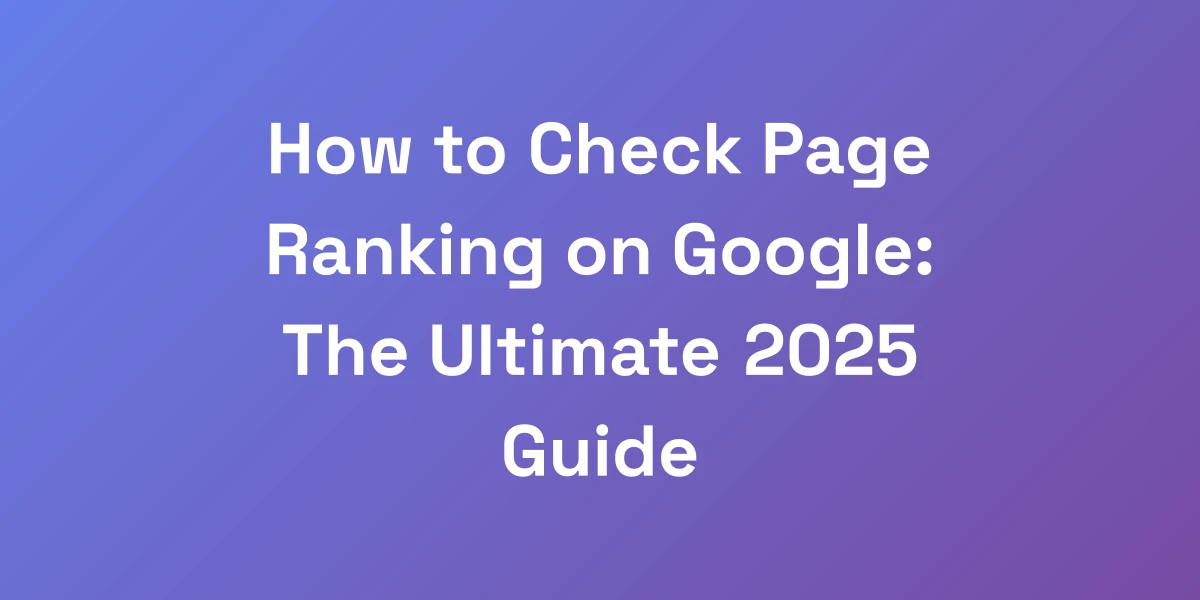
User Experience and SEO: The Ultimate Guide to Ranking Through UX in 2025
Mar 16, 2025 | By [email protected]
The Hidden Money-Making Connection Between UX and SEO
Let me hit you with some truth: if you’re separating UX and SEO, you’re leaving serious money on the table.
I’ve seen businesses 3x their traffic by understanding one simple fact – search engines are becoming increasingly sophisticated at measuring user satisfaction.
When your visitors have a seamless experience, they stay longer, engage more, and signal to Google that your site deserves to rank higher.
It’s not just about keywords anymore; it’s about creating an experience that makes users want to stick around and take action.
Why Google Now Prioritizes User Experience Signals
Google’s algorithm has evolved. Gone are the days when keyword stuffing could skyrocket your rankings. Today, Google prioritizes user experience signals to determine the relevance and quality of your website.
With the latest updates, metrics like Largest Contentful Paint (LCP), Cumulative Layout Shift (CLS), and Interaction to Next Paint (INP) are crucial. These Core Web Vitals serve as indicators of how users perceive the experience of interacting with your site.
Imagine visiting a store where everything is scattered and hard to find. Frustrating, right? Google feels the same way about poorly structured websites. A well-optimized UX ensures that users find what they need effortlessly, leading to higher satisfaction and better rankings.
Are you ready to align your website with what Google truly values? Let’s dive deeper.
The ROI of Investing in Both UX and SEO
Investing in UX and SEO isn’t just a cost; it’s a strategic investment with substantial returns.
Consider a global e-commerce brand that improved its CLS score from 0.25 to 0.05. This optimization led to a 15% increase in conversions within three months.
That’s not just traffic growth; that’s real revenue. By enhancing UX, you’re not only improving your site’s appeal but also directly impacting your bottom line.
Think about it: better UX leads to longer site visits, more engaged users, and ultimately, higher conversion rates. The synergy between UX and SEO amplifies these benefits, creating a robust foundation for sustainable growth.
Are you maximizing your site’s potential by harnessing both UX and SEO? If not, you’re missing out on significant gains.
Core Web Vitals: The Game-Changing Metrics
Core Web Vitals have become the cornerstone of Google’s ranking factors. These metrics provide a clear framework for what constitutes a good user experience.
- Largest Contentful Paint (LCP): Measures loading performance. A good LCP is below 2.5 seconds.
- Cumulative Layout Shift (CLS): Assesses visual stability. Aim for a CLS below 0.1.
- Interaction to Next Paint (INP): Evaluates responsiveness. Keep INP below 200 milliseconds.
Meeting these thresholds is non-negotiable for maintaining and improving search visibility. Google’s tightening of these standards in 2025 reflects its commitment to rewarding sites that prioritize user satisfaction.
Imagine hosting a dinner party but arriving late, presenting a disorganized spread. How would your guests feel? Similarly, a site failing Core Web Vitals leaves users disappointed, prompting them to leave before engaging with your content.
How Poor UX Kills Your SEO Efforts
Poor UX is like building a beautiful house with no doors. It might look good, but you can’t interact with it effectively.
Websites with slow load times, confusing navigation, and unresponsive design face high bounce rates. Users quickly abandon sites that frustrate them, sending negative signals to search engines.
For instance, U.S. retail sites averaging 6.3 seconds to load on mobile drastically exceed Google’s mobile page load recommendation of 3 seconds. This sluggishness not only frustrates users but also plummets your SEO rankings.
Can you afford to drive potential customers away with a subpar user experience? Think about the lost opportunities and the damage to your brand reputation.
The Psychological Factors Behind User Engagement
Understanding the psychology behind user engagement is crucial for optimizing both UX and SEO.
Humans are wired to seek efficiency and satisfaction. When users find what they’re looking for quickly and effortlessly, their positive emotions translate into better engagement metrics.
Elements like intuitive design, clear calls-to-action, and visual appeal cater to these psychological needs, encouraging users to explore more and interact with your content.
Have you considered how psychological triggers like trust, ease of use, and aesthetic pleasure influence user behavior and, consequently, your SEO performance? Understanding human search behavior patterns is essential for this alignment.
Critical UX Elements That Directly Impact Your SEO Rankings
Listen up, because this is where most people mess up. Your website’s UX elements aren’t just pretty features – they’re ranking factors that directly influence your SEO success.
I’ve analyzed hundreds of websites, and the ones dominating search results all nail these fundamental UX components.
From lightning-fast load times to intuitive navigation, every element must be optimized for both humans and search engines. Let me show you exactly what moves the needle.
Page Speed Optimization Techniques That Work
Page speed is non-negotiable. A one-second delay can reduce your conversions by 7%, and slow sites have a 16% lower average time on site.
Here are actionable techniques to boost your page speed:
- Optimize Images: Use next-gen formats like WebP and compress images without losing quality.
- Leverage Browser Caching: Store static files in users’ browsers to reduce load times on subsequent visits.
- Minify CSS, JavaScript, and HTML: Remove unnecessary characters to decrease file sizes and improve loading speed.
- Use a Content Delivery Network (CDN): Distribute your content across global servers to ensure faster access for users everywhere.
Implementing these techniques not only enhances user experience but also sends positive signals to search engines, boosting your SEO rankings. For more detailed insights, refer to the Global Page Speed 2023 report.
Mobile-First Design Principles
With mobile traffic accounting for 59% of all web traffic, mobile-first design is no longer optional; it’s essential.
Here’s how to excel in mobile-first design:
- Responsive Layouts: Ensure your website adapts seamlessly to different screen sizes and orientations.
- Touch-Friendly Navigation: Design buttons and links that are easy to tap without accidental clicks.
- Fast Mobile Load Times: Prioritize speed optimization techniques tailored for mobile devices.
- Accessible Content: Make sure text is readable without zooming and that all interactive elements are easily accessible.
Google’s mobile-first indexing means that your mobile site is the primary basis for indexing and ranking. A well-designed mobile experience directly impacts your SEO performance.
Navigation Structure and Internal Linking
Imagine trying to find a book in a library with no catalog. Frustrating, right? That’s what poor navigation feels like for users.
Effective navigation and internal linking enhance user experience and SEO by:
- Improving Crawlability: A clear structure helps search engines index your pages efficiently.
- Enhancing User Journey: Intuitive navigation guides users to relevant content, increasing engagement and reducing bounce rates.
- Boosting Page Authority: Strategic internal links distribute link equity across your site, strengthening SEO for key pages.
Ensure your navigation is logical, with categories that make sense to both users and search engines. Implement breadcrumb trails and use descriptive anchor texts to further enhance usability and SEO.
Content Readability and Visual Hierarchy
Could your content be as engaging as a best-selling novel? If not, you’re missing out on critical user engagement opportunities.
Here’s how to improve content readability and visual hierarchy:
- Use Clear Headings: Organize content with descriptive headings and subheadings to guide readers.
- Short Paragraphs: Break content into digestible chunks to maintain reader interest.
- Bullet Points and Lists: Highlight key information and make it easily scannable.
- Consistent Typography: Use fonts and sizes that enhance readability without causing strain.
A well-structured page not only keeps users engaged but also helps search engines understand your content better, improving your SEO rankings. To further enhance your content strategy, explore effective blogging for business strategies.
Site Architecture for Maximum Crawlability
Think of your website as a city map. A well-planned architecture ensures that both users and search engines can navigate it effortlessly.
To achieve maximum crawlability:
- Flat Site Structure: Keep important pages within a few clicks from the homepage.
- XML Sitemaps: Provide search engines with a roadmap of your site’s pages.
- Clean URL Structures: Use descriptive, keyword-rich URLs that are easy to read.
- Avoid Duplicate Content: Ensure each page has unique content to prevent search engines from penalizing your site.
Optimizing your site architecture not only enhances user experience but also ensures that search engines can index your content effectively, boosting your SEO efforts.
Interactive Elements That Boost Engagement
Interactive elements like quizzes, polls, and dynamic content can transform a static website into an engaging experience.
Here’s how to effectively use interactive elements:
- Quizzes and Polls: Encourage user participation and gather valuable feedback.
- Interactive Infographics: Present data in a visually appealing and engaging manner.
- Live Chat Features: Provide real-time assistance to enhance user satisfaction.
- Dynamic Content: Use personalized content that adapts based on user behavior.
These elements not only keep users engaged but also increase time on site and reduce bounce rates, both of which are crucial for SEO rankings.
Advanced UX Optimization Strategies for Higher Rankings
Want to know what separates the 6-figure websites from the 7-figure ones? It’s the ability to implement advanced UX optimization strategies that your competitors aren’t even thinking about.
I’m talking about sophisticated techniques that go beyond the basics and create an experience so compelling that users can’t help but engage.
These are the exact strategies I’ve used to help clients dominate their markets.
User Intent Mapping and Content Alignment
Understanding user intent is like having a roadmap to their needs and desires.
Here’s how to align your content with user intent:
- Keyword Research: Identify the intent behind search queries (informational, navigational, transactional).
- Content Mapping: Align your content to address different stages of the user journey.
- Answer User Questions: Provide comprehensive answers that satisfy the user’s search intent.
- Content Formats: Use various formats (blogs, videos, infographics) to match user preferences.
By aligning your content with user intent, you increase relevance and engagement, leading to better SEO performance. For a deeper dive, the Ultimate Guide to SEO for UX Designers is an invaluable resource.
Are you truly meeting the needs of your audience, or are you just guessing what they want?
Micro-Interactions That Drive Engagement
Micro-interactions are the subtle interactions that enhance the user experience without being intrusive.
Implement these to boost engagement:
- Hover Effects: Provide visual feedback when users interact with elements.
- Button Animations: Make calls-to-action more enticing and noticeable.
- Progress Indicators: Show users the status of their actions, like form submissions.
- Notifications: Inform users of real-time updates or actions taken.
These small touches can significantly improve user satisfaction and encourage more prolonged interaction with your site.
Have you considered the impact of these tiny details on your overall user experience?
Advanced A/B Testing Methodologies
A/B testing isn’t just about swapping colors; it’s a strategic tool to optimize every aspect of your user experience.
Here’s how to conduct advanced A/B tests:
- Hypothesis-Driven Testing: Start with a clear hypothesis based on user data and research.
- Multivariate Testing: Test multiple variables simultaneously to understand their combined effects.
- Segmented Testing: Analyze results across different user segments (new vs. returning, mobile vs. desktop).
- Statistical Significance: Ensure your tests run long enough to gather reliable data.
Advanced A/B testing allows you to make data-driven decisions that enhance user experience and drive higher conversions.
Are you leveraging A/B testing to its full potential, or are you sticking to basic tests that offer limited insights?
Personalization Techniques for Better UX
Personalization is the key to making users feel valued and understood.
Implement these personalization techniques:
- Dynamic Content: Show content based on user behavior, location, or preferences.
- Personalized Recommendations: Suggest products or content that align with user interests.
- User Profiles: Allow users to create profiles that tailor their experience on your site.
- Email Personalization: Send targeted emails based on user interactions and preferences.
Personalized experiences lead to higher engagement, better user satisfaction, and improved SEO metrics.
How personalized is your current user experience strategy?
Voice Search Optimization Through UX
With 35% of all Google searches being voice searches, optimizing for voice is no longer optional.
Here’s how to optimize UX for voice search:
- Conversational Content: Use natural language that matches how people speak.
- Featured Snippets: Structure content to answer common voice queries concisely.
- Local SEO: Optimize for local searches, as many voice queries are location-based.
- Schema Markup: Implement structured data to help search engines understand your content better.
Voice search optimization enhances user experience by providing quick and relevant answers, which can boost your SEO rankings.
Are you prepared to meet the growing demand for voice search?
AI-Powered UX Improvements
Artificial Intelligence isn’t just a buzzword; it’s a powerful tool for enhancing user experience.
Leverage AI in your UX strategy by:
- Chatbots: Provide instant support and guide users through their journey.
- Predictive Analytics: Anticipate user needs and personalize their experience accordingly.
- Content Generation: Use AI to create dynamic and relevant content in real-time.
- User Behavior Analysis: Utilize AI to gain deeper insights into user interactions and preferences.
These advancements, including SEO automation, can significantly enhance user satisfaction, leading to better engagement metrics and improved SEO performance.
Is your website leveraging AI to deliver a superior user experience?
Measuring and Optimizing UX-SEO Performance
Here’s the brutal truth: if you’re not measuring your UX-SEO efforts, you’re just guessing.
I’m going to show you exactly how to track and optimize the metrics that matter.
We’re talking about real data that shows you where users are getting stuck, why they’re leaving, and most importantly – how to fix it.
This isn’t theory; these are battle-tested methods that have generated millions in revenue for my clients.
Essential UX-SEO Analytics Tools
To effectively measure your UX-SEO performance, you need the right tools in your arsenal.
- Google Analytics: Track user behavior, traffic sources, and conversion rates.
- Hotjar: Utilize heatmaps and session recordings to understand user interactions.
- SEMrush: Monitor your SEO performance and identify areas for improvement. Discover the best SEO tools for agencies to enhance your strategies.
- Google Search Console: Analyze your site’s presence in Google search results and troubleshoot issues.
- Crazy Egg: Gain insights into user engagement with detailed heatmaps and scroll maps.
- Top UX Tools in 2023: Explore the latest top UX tools to enhance your design and optimization processes.
These tools provide comprehensive data to help you refine your UX and SEO strategies continuously.
Key Performance Indicators to Track
Focusing on the right KPIs is critical for evaluating your UX-SEO efforts.
- Page Load Time: Faster load times improve user satisfaction and SEO rankings.
- Bounce Rate: Lower bounce rates indicate better user engagement.
- Time on Site: Higher time on site reflects increased user interest and content quality.
- Pages per Session: More pages per session suggest effective internal linking and content relevance.
- Conversion Rate: Directly ties UX improvements to business outcomes.
Regularly monitoring these KPIs allows you to identify strengths and weaknesses in your UX-SEO strategy.
Are you tracking the metrics that truly impact your SEO performance?
User Behavior Analysis Techniques
Understanding how users interact with your site is key to optimizing their experience.
- Session Recordings: Watch how users navigate your site to identify pain points.
- Heatmaps: Visualize where users click, scroll, and spend the most time.
- Surveys and Feedback Forms: Gather direct feedback to understand user preferences and frustrations.
- Funnel Analysis: Track the user journey to identify where drop-offs occur.
These techniques provide deep insights into user behavior, enabling you to make informed decisions to enhance both UX and SEO.
How well do you understand the behavior of your site’s visitors?
Conversion Rate Optimization Methods
Improving your conversion rate is the ultimate measure of your UX-SEO success.
Here are effective methods to optimize conversions:
- A/B Testing: Experiment with different designs, layouts, and content to see what works best.
- Clear Calls-to-Action: Make your CTAs prominent and compelling to guide users towards desired actions.
- Streamlined Forms: Simplify forms to reduce friction and increase completion rates.
- Trust Signals: Incorporate testimonials, reviews, and security badges to build credibility.
By focusing on these methods, you can turn more visitors into customers, enhancing both your UX and SEO outcomes.
Are your CTAs converting as effectively as they should?
ROI Calculation for UX Improvements
Calculating the ROI of your UX improvements ensures that your efforts are financially justified.
Here’s how to calculate ROI:
- Identify Costs: Include design, development, testing, and tool expenses.
- Measure Gains: Track increases in conversions, sales, and user engagement metrics.
- Calculate ROI: Use the formula ((Gains – Costs) / Costs) x 100 to determine your return on investment.
For example, if you spend $10,000 on UX improvements and generate an additional $30,000 in revenue, your ROI is 200%.
Understanding ROI helps you allocate resources effectively and prioritize strategies that deliver the highest returns.
Are you able to quantify the value of your UX investments?
Continuous Improvement Framework
The digital landscape is ever-changing, making continuous improvement essential for sustained UX-SEO success.
Adopt a continuous improvement framework by:
- Regular Audits: Conduct periodic UX and SEO audits to identify new areas for enhancement.
- User Feedback Loops: Implement systems to gather and act on user feedback consistently.
- Agile Methodology: Use agile practices to iterate and implement changes quickly.
- Stay Updated: Keep abreast of the latest UX and SEO trends and algorithm updates.
By fostering a culture of continuous improvement, you ensure that your website remains optimized and competitive.
How are you ensuring that your UX and SEO strategies evolve with changing trends?
Conclusion
We’ve journeyed through the intricate relationship between User Experience and SEO, uncovering how a seamless UX not only delights users but also propels your site up the search rankings.
From understanding the critical role of Core Web Vitals to implementing advanced UX strategies, the path to SEO success is paved with thoughtful design and strategic optimization.
Remember, investing in UX is not just about aesthetics; it’s about creating an environment where users thrive, engage, and convert.
Ready to transform your website into a user-centric, SEO powerhouse? Start implementing these strategies today and watch your rankings—and revenue—soar.
What steps will you take to enhance your site’s user experience and boost your SEO rankings? Share your thoughts and experiences in the comments below!








